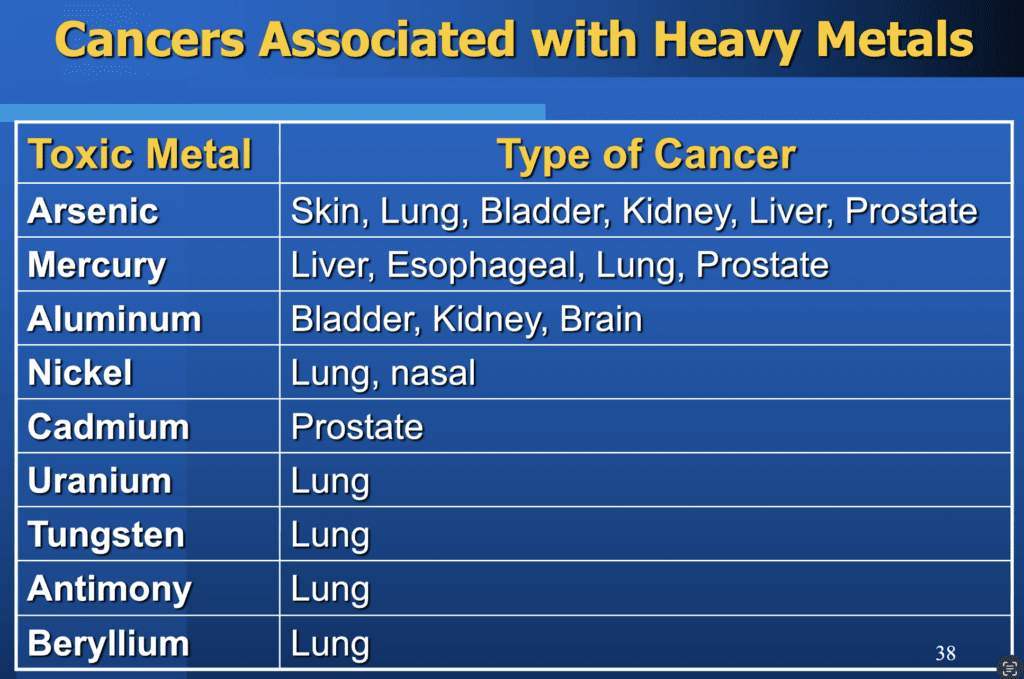Since industrialization began, people have explored uses for Earth’s numerous resources to fuel engines and provide power globally. Unfortunately, this advancement has led to the release of millions of tons of toxic metals into our waters, soil, and the air we breathe. The consequences of global industrial pollution over the last two centuries to today are a continued threat to our lifelong health and vitality.
Risks from heavy metal toxicity

Lead exposure is still a concern
Many Americans were continuously exposed to lead from car exhaust, industry, and paint throughout the 20th century with notable effects on mortality. It would be convenient to assume the threat is a thing of the past, however, the ban on leaded gas came only in 1996 and exempted race cars and airplanes. Until as recently as 2007, for example, the consequences of the release of lead-ridden fumes into the atmosphere by race cars at NASCAR measurably lowered test scores in schools near the tracks. What happened in 2007? NASCAR switched to unleaded.
Our lifetime exposure to lead matters. Because lead is stored in bone tissue, during periods of increased bone turnover — like pregnancy, some disease processes, and after middle age, lead is released back into the body. This secondary lead exposure can be a critical concern for the healthspans of anyone born before 1996 or who lived in proximity to racetracks, airports, or industrial sites.
Ongoing mercury exposure risk
At the same time, atmospheric plumes of mercury sourced in China have been documented entering global waterways, including the seafood-rich Pacific Northwest America. This neurotoxic pollutant gets absorbed into the bodies of the culturally significant and treasured salmon species of the region (among other cherished kinds of seafood). The release of these metals into the environment has resulted in adverse health events due to the toxicological nature of these pollutants.
Heavy metals and cancer risk
These metals disrupt cellular processes, damage DNA, and impair the body’s natural defense mechanisms, making cells more susceptible to malignant transformation. Long-term exposure to heavy metals, especially in occupational settings or regions with high pollution levels, poses a significant health concern. Regular monitoring, awareness, and proactive measures to reduce heavy metal exposure are crucial in minimizing cancer risks and promoting overall well-being.

Continuous exposure to heavy metals can be disastrous for human health and can induce a profound effect on the population. These heavy metals and many others create a need for a method that can help to remove them from the human body.
How to reduce heavy metals in the body
IV Chelation therapy is a highly effective, but also safe procedure that binds chelation agents to heavy metals and removes them from the body.

What is chelation?
Chelation is the formation of a complex that sits between a ligand and a metal ion. It’s a process where an organic molecule (the ligand) would remove certain heavy metals from the human body. Apart from heavy metals, chelation can be used to bind to other molecules as well. One example includes free radicals, which are molecules in the body that cause oxidative stress and damage tissues.
It is a highly effective process for removing heavy metals from the body, especially when these metals are causing health-related problems. Two main types of chelation exist, each with its own benefits and limitations.
Intravenous (IV) chelation therapy injects a chelating agent into the patient’s body. The chelation agents then bind to the heavy metals in an attempt to remove them. Gastrointestinal (GI) chelation is also used, in which the chelation agent is ingested in the form of a pill or rectal suppository.
Overall, chelation therapy is considered safe and very effective. It is an ideal therapeutic process to address acute heavy metal poisoning as well as remove chronic levels of heavy metals when there are concerns about health problems.

Why do we need chelation therapy?
Because they are not excreted naturally and accumulate with time in soft tissues and bones, toxic metals can cause a number of health problems even at low levels, including cognitive issues. The most common toxic metals include lead, mercury, arsenic, cadmium, nickel, and aluminum. These metals can lead to cell membrane damage, increase oxidative stress, and promote the production of free radicals in the human body. Lead is shown to cause hypertension by inactivating nitric oxide, creating oxygen radicals, and its effects on vascular smooth muscle. Furthermore, the absorbed metal traces combine with other reactive toxins from the environment, food, and water to increase AGEs (advanced glycation endproducts) — potent inflammatory proteins connected with acute and chronic autoimmune diseases such as Alzheimer’s disease and diabetes.
Toxic metals are nearly ubiquitous in our contemporary world and are found seemingly everywhere. For example, on any given day a person may absorb metals into their body from inhaling leaded gasoline exhaust over a lifetime, using cadmium-enriched beauty products, or even drinking from public water systems. Heavy metals are found in high fructose corn syrup, air pollution, industrial exhaust, and more. Occupational exposures to metals also carry negative health consequences for those in associated industries.
These absorbed or inhaled toxins have the potential to wreak havoc on the body by increasing oxidative stress, harming organs and tissues, and increasing the risk of developing cardiovascular disease among other illnesses. While the environmental pollution of metals has exacted a toll on the health of those exposed to them, novel medical interventions — such as chelation therapy — resolve the toxicity through a delicate removal process led by the experts at ViveWell.
Toxic metal removal with chelation therapy
In chelation therapy, special chemicals that bind with minerals (known as chelators) are delivered into your bloodstream, typically starting with intravenous therapy but also using oral medications. These chelators attach to toxic metals in the body, allowing them to finally be removed and excreted.
Before beginning IV chelation therapy, we consider your symptoms, history of exposures, and offer blood metal level screening to evaluate the level of metals in your body. Unfortunately, most metals become packed away in the bone or other organs, so it’s difficult to know exactly how much “reservoir” of toxin your body has accumulated.
Some of the common metals found in these screenings include aluminum, barium, arsenic, cadmium, mercury, and lead. Remember that accumulation of these toxic metals can lead to systemic inflammation and is linked to a number of metabolic disorders, cardiovascular disease, arthritic conditions, and neurological disorders (Parkinson’s Disease, Alzheimer’s disease, etc.) We safely remove this accumulation of toxic metals over a series of treatments to bring your body’s systems to a healthy place with gentle but persistent therapy.
During your IV chelation therapy, our team will monitor the levels of metals in the blood carefully using pre- and post-treatment testing. We offer IV chelation therapy with EDTA or DMPS to help remove the metal burden to lower levels, making treatment continuation decisions pending on how each patient is responding.

Benefits of Chelation Therapy at ViveWell
- Reduces oxidative stress on the body
- Effectively removes toxic metals
- Reduces risk for cardiovascular disease
- Restores distribution of essential minerals, and nutritional metallic elements
- Relieves symptoms of fatigue, anxiety, and/or depression
- Improved libido, erectile function, and prostate conditions
- Improved energy and endurance
- Enhanced overall quality of life
We offer IV chelation therapy with EDTA and DMPS, and oral chelation with DMSA and DMPS to help remove the patient’s toxic metal burden. Meet with your ViveWell provider to discuss what treatment plan is right for you.
Blood levels reflect acute exposure to mercury, cadmium, arsenic, and others. Lead is stored in the bone and is released with bone turnover in middle age, which is why thyroid and hormone optimization is so important to keep the lead in your bone. This secondary reexposure causes continued worsening.
Oftentimes there are hidden metals not routinely screened for in blood that are released in the urine after chelation.
In comparison, the Urine Toxic Metals Test is commonly employed to assess the presence of harmful substances and the loss of essential nutrients in the body. Furthermore, by comparing the concentrations of urine toxic metals before and after using a chelator, it’s possible to estimate the overall accumulation, net retention, of potentially toxic elements. Subsequent urine element analyses, performed after administering a chelator, are valuable for monitoring the effectiveness of metal detoxification treatment.

How Chelation Therapy works
The first step is to choose the right chelation agent to use during the therapy. IV infusions are an effective way to ensure optimal absorption and maximum availability of chelation agents. Oral dosing of chelators allows patients to have continued results with convenience.
The therapy itself is performed in a professional setting and can last for a couple of hours, depending on the severity of heavy metal accumulation. A series of IV infusions may also be given during this time. A preliminary test will help the administrator to determine the right chelation agent to use and the number of IV infusions that are necessary. The concentration of the chelation agent also needs to be determined prior to the IV infusions.
EDTA
Ethylenediaminetetraacetic acid (EDTA) is commonly used for IV chelation therapy. EDTA is a versatile chelator that primarily targets and chelates divalent cations, such as calcium, lead, and other heavy metals — with a particular affinity for lead and is FDA-approved. It forms stable complexes with these metals which are then excreted in urine.
DMPS
DMPS is a versatile chelation agent with a unique molecular structure that enables it to chelate a wide range of heavy metals, including mercury, lead, cadmium, and arsenic. This agent has the remarkable capacity to penetrate cellular membranes, allowing it to access intracellular compartments where heavy metals often accumulate. It comes in both IV and oral capsules, so we have flexibility in its use.
By binding to heavy metals, DMPS forms stable complexes known as chelates, which are then eliminated from the body through organs like the kidneys and liver. DMPS not only removes toxic heavy metals but also restores cellular functions and exhibits antioxidant properties. This makes DMPS an effective tool in treating heavy metal poisoning and addressing chronic health conditions associated with heavy metal accumulation. DMPS unlocks the body’s innate detoxification potential, promoting overall well-being.
DMSA
DMSA is an oral chelating agent that primarily acts as a water-soluble chelator, meaning it forms stable complexes with heavy metals that are soluble in water. It has a greater affinity for lead and is often used in the treatment of lead poisoning. Additionally, DMSA binds cadmium and has some mercury effectiveness. DMSA can penetrate cellular membranes, accessing intracellular compartments where heavy metals tend to accumulate. It promotes the elimination of heavy metals through urine and feces, restoring cellular functions impaired by their presence. Additionally, DMSA exhibits antioxidant properties, aiding in reducing oxidative stress associated with heavy metal toxicity.
Possible reactions to chelation agents
Although we’re committed to a gentle process of removing toxins from the body, some people can experience adverse reactions, often mild. We make sure to administer these medications slowly to avoid unwanted dizziness, weakness, palpitations or temporary low blood pressure.
Nausea, vomiting and diarrhea, a metallic taste in the mouth, or an odor in body excretions can occur. For this, we recommend peppermint/ginger tea and peppermint tablets to alleviate the symptoms.
Although rare, some patients can experience itching or rashes, similar to an allergic skin reaction. This can be treated with B12 injections, which is a standard addition to our IV chelations.
Lastly, it’s important to closely monitor liver and kidney function through routine, inexpensive blood work, typically drawn every 6-8 weeks, or as necessary.
ViveWell Chelation Therapy options
- IV Chelation session – we have a standard 1500 mg Calcium (or disodium) EDTA chelation infusion in the office — $175. However, to make it more convenient, patients can elect to add 1500mg of EDTA ($50) to most infusion options. Or they can maximize their IV chelation procedure with up to an additional 1500 mg of EDTA for $50, but it adds time to the infusion process.
- Oral Chelation in between IV sessions (prescription from ViveWell Provider)
- Chezone — Ozone major autohemotherapy (MAH, ozone therapy) and chelation. In this procedure, the patient receives MAH and afterward an infusion of EDTA, possibly DMPS, and other nutrients to chelate them. Learn more about Chezone at ViveWell.
- IV nutrient replacement afterward or choose to take supplements at home.
- Myers Cocktail
- Add high dose vitamin C, $60 per 25g (must have G6PD to add more than 25g)
How to maximize chelation results?
Recommended for all chelation treatments. Our supplement protocol:
- Vitamin C | 3,000 – 12,000 mg daily
- Multi-vitamin
- N-acetyl-cysteine (NAC) | 600 mg once or twice daily
- Whey Protein Powder | 2 tablespoons daily
- Fiber (RBF/Psyllium) | 3-7 caps at night with water
- Hydrochloric acid (Betaine HCL) with meals
- Urine alkalinizing support (potassium bicarbonate or potassium citrate) see Shop
- In between chelation cycles – consider additional minerals and trace elements. Extra magnesium (either glycinate, maleate, or threonate) is generally needed.
- Probiotics
- Sauna, hot bath, or exercise to speed up detoxification through your body’s largest organ — the skin.

Conclusion
IV chelation therapy offers a safe way to treat problems like heavy metal poisoning and reduces the impact that these molecules have on the human body. It’s a relatively simple treatment procedure that allows a chelation agent to bind to heavy metals, ultimately removing them through urine. In addition to IV chelation therapy, a combination of additional therapeutic approaches can be taken to further enhance the result that the patient can experience.
References
- Rai, G. K., Bhat, B. A., Mushtaq, M., Tariq, L., Rai, P. K., Basu, U., … & Bhat, J. A. (2021). Insights into decontamination of soils by phytoremediation: A detailed account on heavy metal toxicity and mitigation strategies. Physiologia Plantarum, 173(1), 287-304. Retrieved from https://pubmed.ncbi.nlm.nih.gov/33864701/
- Hollingsworth, A., & Rudik, I. (2021). The effect of leaded gasoline on elderly mortality: Evidence from regulatory exemptions. American Economic Journal: Economic Policy, 13(3), 345-73. Retrieved from https://www.aeaweb.org/articles?id=10.1257/pol.20190654
- Chen, L., Liang, S., Liu, M., Yi, Y., Mi, Z., Zhang, Y., … & Yang, Z. (2019). Trans-provincial health impacts of atmospheric mercury emissions in China. Nature Communications, 10(1), 1484. Retrieved from https://www.nature.com/articles/s41467-019-09080-6#:~:text=China%20is%20the%20largest%20Hg,decades28%2C29%2C30.
- Wood, S. China’s mercury flushes into Oregon’s rivers.(2008). The Oregonian.Retrieved from https://www.oregonlive.com/environment/2008/04/chinas_mercury_flushes_into_or.html
- Nong, Q., Dong, H., Liu, Y., Liu, L., He, B., Huang, Y., … & Hu, L. (2021). Characterization of the mercury-binding proteins in tuna and salmon sashimi: Implications for health risk of mercury in food. Chemosphere, 263, 128110. Retrieved from https://www.sciencedirect.com/science/article/abs/pii/S0045653520323055
- Briffa, J., Sinagra, E., & Blundell, R. (2020). Heavy metal pollution in the environment and their toxicological effects on humans. Heliyon, 6(9), e04691. Retrieved from https://www.sciencedirect.com/science/article/pii/S2405844020315346
- Ouyang, L., Li, Q., Rao, S., Su, R., Zhu, Y., Du, G., … & Fan, G. (2023). Cognitive outcomes caused by low-level lead, cadmium, and mercury mixture exposure at distinct phases of brain development. Food and Chemical Toxicology, 175, 113707. Retrieved from https://pubmed.ncbi.nlm.nih.gov/36893892/
- Valko, M. M. H. C. M., Morris, H., & Cronin, M. T. D. (2005). Metals, toxicity and oxidative stress. Current Medicinal Chemistry, 12(10), 1161-1208.Retrieved from https://www.ingentaconnect.com/content/ben/cmc/2005/00000012/00000010/art00003
- Karapetyan, G., Fereshetyan, K., Harutyunyan, H., & Yenkoyan, K. (2022). The synergy of β amyloid 1-42 and oxidative stress in the development of Alzheimer’s disease-like neurodegeneration of hippocampal cells. Scientific Reports, 12(1), 17883. Retrieved from https://www.nature.com/articles/s41598-022-22761-5
- Goh, S. Y., & Cooper, M. E. (2008). The role of advanced glycation end products in progression and complications of diabetes. The Journal of Clinical Endocrinology & Metabolism, 93(4), 1143-1152. Retrieved from https://academic.oup.com/jcem/article/93/4/1143/2826132
- Parker, K., Salas, M., & Nwosu, V. C. (2010). High fructose corn syrup: production, uses and public health concerns. Biotechnology &l Molecular Biology Review, 5(5), 71-78. Retrieved from https://academicjournals.org/article/article1380113250_Parker%20et%20al.pdfhost%26scope%3dsite%26authtype%3dcrawler%26jrnl%3d09757619%26AN%3d134257003
- Hengstler, J. G., Bolm-Audorff, U., Faldum, A., Janssen, K., Reifenrath, M., Götte, W., … & Oesch, F. (2003). Occupational exposure to heavy metals: DNA damage induction and DNA repair inhibition prove co-exposures to cadmium, cobalt and lead as more dangerous than hitherto expected. Carcinogenesis, 24(1), 63-73. Retrieved from https://academic.oup.com/carcin/article/24/1/63/2608351
- Alissa, E. M., & Ferns, G. A. (2011). Heavy metal poisoning and cardiovascular disease. Journal of Toxicology, 2011 Retrieved from https://pubmed.ncbi.nlm.nih.gov/21912545/
- Lamas, G. A., Anstrom, K. J., Navas-Acien, A., Boineau, R., Kim, H., Rosenberg, Y., … & TACT2 Investigators. (2022). The Trial to Assess Chelation Therapy 2 (TACT2): Rationale and Design. American Heart Journal. Retrieved from https://www.sciencedirect.com/science/article/pii/S0002870322001053
- Lamas, Gervasio A., et al. “Design of the trial to assess chelation therapy (TACT).” American Heart Journal 163.1 (2012): 7-12. Retrieved from https://www.ncbi.nlm.nih.gov/pmc/articles/PMC3243954/?_escaped_fragment_=po=31.2500
- Ravalli, F., Vela Parada, X., Ujueta, F., Pinotti, R., Anstrom, K. J., Lamas, G. A., & Navas‐Acien, A. (2022). Chelation therapy in patients with cardiovascular disease: a systematic review. Journal of the American Heart Association, 11(6), e024648. Retrieved from https://www.ahajournals.org/doi/pdf/10.1161/JAHA.121.024648
- Lamas, G. A., Navas-Acien, A., Mark, D. B., & Lee, K. L. (2016). Heavy metals, cardiovascular disease, and the unexpected benefits of chelation therapy. Journal of the American College of Cardiology, 67(20), 2411-2418. Retrieved from Heavy Metals, Cardiovascular Disease, and the Unexpected Benefits of Chelation Therapy | Journal of the American College of Cardiology (jacc.org)
- Pamphlett, R., & Kum Jew, S. (2019). Mercury is taken up selectively by cells involved in joint, bone, and connective tissue disorders. Frontiers in Medicine, 6, 168. Retrieved from https://www.ncbi.nlm.nih.gov/pmc/articles/PMC6659129/
- Vaziri ND, “Lead induced Hypertension: Role of Oxidative Stress, Curr Hypertens Rep. 2004 Aug;6(4):314-20
- De Visé, D. (2022, November 3). The Hill. The Hill. https://thehill.com/changing-america/sustainability/3716345-how-nascars-switch-to-unleaded-gas-boosted-test-scores-near-racetracks/






